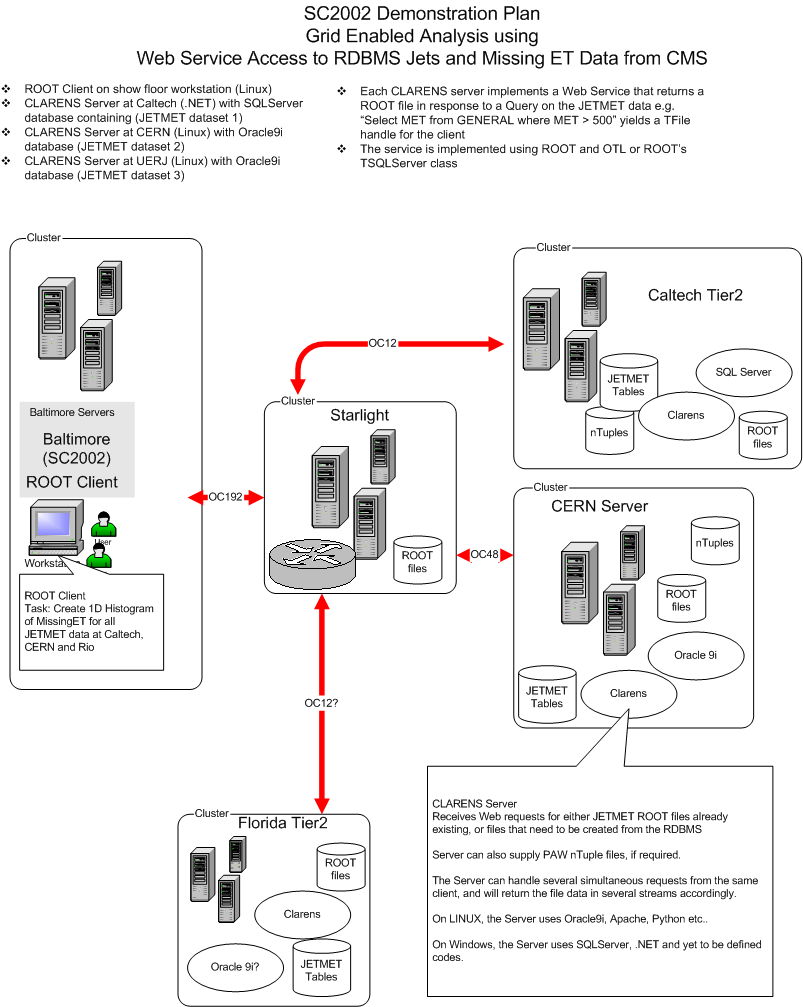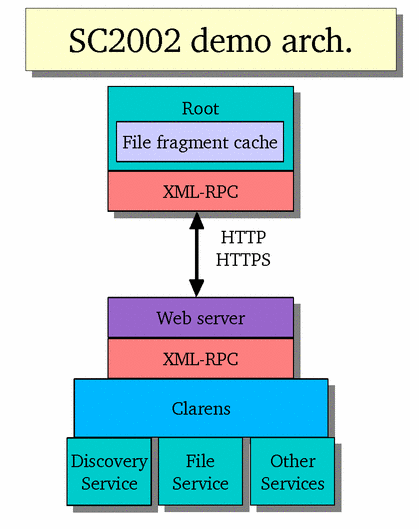"Bandwidth Gluttony - Distributed Grid-Enabled Particle Physics Event Analysis over enhanced TCP/IP"
An entry for the SC2002 Bandwidth Challenge Event.
Eric Aslakson (aslakson@hep.caltech.edu) Julian Bunn (julian@cacr.caltech.edu) Saima Iqbal (Saima.Iqbal@cern.ch) Cheng Jing (chengjin@cs.caltech.edu) Steven Low (slow@caltech.edu) Harvey Newman (newman@hep.caltech.edu) Sylvain Ravot (Sylvain.Ravot@cern.ch) Suresh Singh (suresh@cacr.caltech.edu) Edwin Soedarmadji (edwin@hep.caltech.edu) Conrad Steenberg (conrad@hep.caltech.edu) David Wei (weixl@cs.caltech.edu)

Description
Using distributed databases at Caltech, CERN, possibly UCSD and other HEP institutes, we will show
- a "Grid-Enabled" particle physics analysis application that issues remote database selection queries, prepares virtual data object collections, moves those collections across the WAN using specially enhanced TCP/IP stacks, and renders the results in real time on the analysis client workstation in Baltimore. This scheme is a preview of a general "Grid Enabled Analysis Environment" that is being developed for CERN's LHC experiments.
- Use of modified TCP (the FAST project) to achieve excellent throughput for large data transfers in the WAN. Thanks to funding from NSF and other agencies, support from Cisco and other vendors, and a strong team of associates (details appear at the foot of this Web page), rapid progress is being made. Precise details of this aspect of the demo are still being ironed out.
Diagram

Hardware/Software/Networking
The client hardware on the show floor will consist of a head node for display purposes (running the ROOT and MonaLisa applications), twelve latest generation dual processor servers each equipped with a SysKonnect SK9843 Gbit fibre interface. These servers will run the Linux OS with TCP mods. Remotely, at Starlight, Caltech, CERN, Florida and probably at least one other HEP institute, we will make use of Linux and Windows-based servers that host Oracle, SQLServer and probably PostgreSQL database, and which run the Caltech "Clarens" server software that communicates with the ROOT client. Networking will be using various routes. An overview is shown in the Starlight network diagram below.
Publicity
Work on preparing this demonstration is within the context of our recently submitted proposal to NSF to develop TCP/AQM, which was accompanied by letters of support from Internet2, several other research organisations and vendors. We expect this project to consequently have considerable visibility in the networking community (as well as in HEP).
Here is a diagram of the Clarens architecture used on the servers:

Networks and Coordination
- the US-CERN link: dedicated OC48 between StarLight and CERN Contacts Sylvian Ravot (Caltech); Olivier Martin (CERN); Tom de Fanti (Starlight)
- Abilene for links to Caltech using Gigabit Ethernet Contacts: Steve Corbato, Guy Almes (Internet2)
- CALREN peering at the L.A. downtown POPs, Contact: Tom West
- metro dark fiber or CALREN from the LA POP to Caltech. Contacts: James Patton, John Dundas (Caltech)
- AMPATH to Miami and UERJ Rio de Janeiro Contacts: Heidi Alvarez (AMPATH) and Alberto Santoro (UERJ in Rio)
